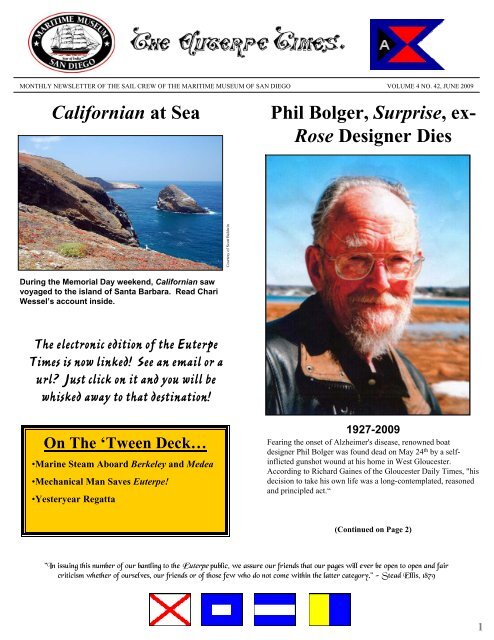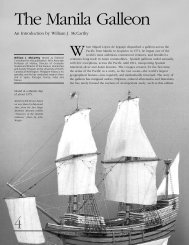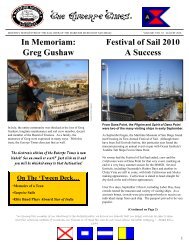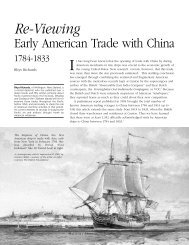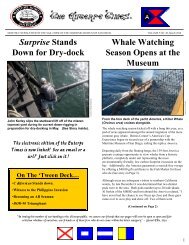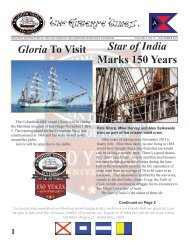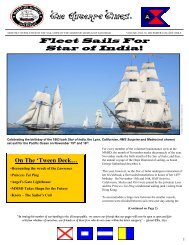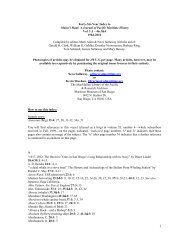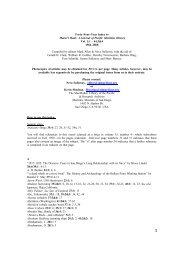Euterpe Times V3 NO. 42 - Maritime Museum of San Diego
Euterpe Times V3 NO. 42 - Maritime Museum of San Diego
Euterpe Times V3 NO. 42 - Maritime Museum of San Diego
You also want an ePaper? Increase the reach of your titles
YUMPU automatically turns print PDFs into web optimized ePapers that Google loves.
MONTHLY NEWSLETTER OF THE SAIL CREW OF THE MARITIME MUSEUM OF SAN DIEGO VOLUME 4 <strong>NO</strong>. <strong>42</strong>, JUNE 2009<br />
Californian at Sea<br />
Phil Bolger, Surprise, ex-<br />
Rose Designer Dies<br />
Courtesy <strong>of</strong> Scott Baldwin<br />
During the Memorial Day weekend, Californian saw<br />
voyaged to the island <strong>of</strong> <strong>San</strong>ta Barbara. Read Chari<br />
Wessel’s account inside.<br />
The electronic edition <strong>of</strong> the <strong>Euterpe</strong><br />
<strong>Times</strong> is now linked! See an email or a<br />
url? Just click on it and you will be<br />
whisked away to that destination!<br />
On The ‘Tween Deck…<br />
•Marine Steam Aboard Berkeley and Medea<br />
•Mechanical Man Saves <strong>Euterpe</strong>!<br />
•Yesteryear Regatta<br />
1927-2009<br />
Fearing the onset <strong>of</strong> Alzheimer's disease, renowned boat<br />
designer Phil Bolger was found dead on May 24 th by a selfinflicted<br />
gunshot wound at his home in West Gloucester.<br />
According to Richard Gaines <strong>of</strong> the Gloucester Daily <strong>Times</strong>, "his<br />
decision to take his own life was a long-contemplated, reasoned<br />
and principled act.“<br />
(Continued on Page 2)<br />
"In issuing this number <strong>of</strong> our bantling to the <strong>Euterpe</strong> public, we assure our friends that our pages will ever be open to open and fair<br />
criticism whether <strong>of</strong> ourselves, our friends or <strong>of</strong> those few who do not come within the latter category." - Stead Ellis, 1879<br />
1
HMS Surprise Dry-dock<br />
Cancelled<br />
Christine Hawes and along with other crew continue<br />
restoration work on the yards <strong>of</strong> HMS Surprise.<br />
It was announced in May that the HMS Surprise's anticipated dry<br />
docking has been cancelled. The dry-dock was in preparation<br />
for an out <strong>of</strong> the region transit to the <strong>San</strong>ta Barbara waters.<br />
With the state <strong>of</strong> the nation's economy effecting all aspects <strong>of</strong><br />
life, many consider a lack <strong>of</strong> funding as the sole source <strong>of</strong> the<br />
museum's decision. While funding is an element in the decision,<br />
other factors added to the decision, the primary cause being the<br />
preservation <strong>of</strong> the Star <strong>of</strong> India. The Star is slated to enter drydock<br />
this July. As previously reported, the last opportunity to<br />
use BAE's "Star-sized" dry-dock is rapidly approaching, as the<br />
historic dry-dock is about to be retired. As Dr. Ray Ashley,<br />
museum directors notes, "For the same reason we decided to<br />
accelerate our application <strong>of</strong> the Ceramkote process to her hull<br />
from a test to a complete coating also – we may not get another<br />
chance for a long time."<br />
Additionally, HMS Surprise's COI allows for a deferment on<br />
dry-docking until 2010 opening the door for a luckily timed<br />
project on behalf <strong>of</strong> the Marine Group. The MMSD prefers that<br />
HMS Surprise be hauled out using the Marine Group's big travel<br />
lift. As some recall, when this was done in 2007, the yard had to<br />
wait nearly a month for a sufficient tide to put her back into the<br />
water. Marine Group by 2010 will have dredged their travel lift<br />
bay to an adequate depth in order to avoid any delays.<br />
In preparation for the dry-dock, HMS Surprise was nearly derigged<br />
completely. With the announcement that the dry-dock<br />
was cancelled, rolled eyes, muffled groans and some chuckles<br />
were passed about. However, the down-rigging has allowed<br />
museum staff and volunteers to gain valuable experience as the<br />
yards are all being refurbished. As work proceeds on the yards<br />
on Car Float No. 7, when Surprise is put back together she will<br />
be nearly good as new.<br />
~ Brad Holderman, MMSD Volunteer, editor.<br />
Courtesy <strong>of</strong> Brad Holderman<br />
Board the Star <strong>of</strong> India and experience a fun,<br />
unique movie venue.<br />
Pick a date, grab a jacket, take a blanket to snuggle up in, and get<br />
ready to be entertained by this grand old lady (the Star <strong>of</strong> India)<br />
in a way unlike any other. Her projection sail raised, her decks<br />
set up for your comfort, her staff and volunteers ready to help<br />
her put on the show; the Star <strong>of</strong> India invites you to her 15th<br />
Movies Before The Mast Film Festival.<br />
Friday nights are Date Nights. Bring a date, win prizes and<br />
snuggle under the stars as you watch:<br />
July 10 th The Perfect Storm (rated PG-13)<br />
August 14 th Deep Blue Sea (rated R)<br />
Saturday nights are Family Nights. It's a fun night for the whole<br />
family. Come a little early, explore the ship, join in the premovie<br />
activities and win prizes, and then watch:<br />
July 11 th Sinbad: Legend <strong>of</strong> the Seven Seas (rated<br />
PG) August 15 th The Sea Gypsies (rated<br />
G)<br />
Ticket Prices<br />
Adults: $13, Children (12 and under): $8<br />
Adult Members*: $11, Member's Children* (12 and under): $6<br />
Show <strong>Times</strong><br />
Box <strong>of</strong>fice opens at 6:30 p.m., Gates open at 7:00 p.m.<br />
Movies begin at 8:00 p.m.<br />
There are <strong>NO</strong> REFUNDS or EXCHANGES so please select<br />
carefully<br />
*Member's must show their membership ID at the box <strong>of</strong>fice<br />
when they check in.<br />
We would like to thank Anthony's for their continued<br />
participation and support.<br />
Go to www.sdmaritime.org for details.<br />
3
Bolger (cont)<br />
Born in Gloucester on December 3rd, 1927, Bolger designed 680<br />
boats over his lifetime. This included the world's smallest<br />
dinghy, "the folding schooner," and the HMS Surprise, ex-HMS<br />
Rose.<br />
keep the gunports closed...but she proved amply stiff in the<br />
event."<br />
In his recollections <strong>of</strong> the design and construction <strong>of</strong> the Rose,<br />
Bolger concludes that "it opened the opportunity to design a big<br />
square-rigger...and indulge a life-long interest in nautical history.<br />
I did not seek or accept any more commissions <strong>of</strong> this type,<br />
being rather more interested in the future than the past."<br />
As Phil Bolger's talents are now part <strong>of</strong> maritime past, he leaves<br />
behind 668 boat designs, 550 magazine articles, and many books.<br />
For the maritime museum <strong>of</strong> <strong>San</strong> <strong>Diego</strong>, one <strong>of</strong> his greater<br />
achievements, the HMS Rose, lies moored alongside the<br />
Berkeley in her new guise as the HMS Surprise.<br />
~ Brad Holderman, MMSD Volunteer, editor.<br />
One <strong>of</strong> Phil Bolger’s better known designs, the<br />
Gloucester Light Dory.<br />
Bolger was the youngest <strong>of</strong> two brothers raised by their mother.<br />
Their father had died <strong>of</strong> a stroke. Boating was an early passion<br />
<strong>of</strong> Bolger's, by the time he was 7, he was commonly hand<br />
carving models.<br />
As a young adult, he attended Bowdoin College, served out an<br />
enlistment in the U.S. Army and returned to Bowdoin to<br />
complete his bachelor's degree in history. Around the time <strong>of</strong><br />
World War II, Bolger apprenticed to John Hacker and Linsdey<br />
Lord, two <strong>of</strong> the pre-eminent naval architects <strong>of</strong> the time.<br />
Bringing boating to the masses was Phil Bolger's lifelong goal.<br />
The multitudes <strong>of</strong> designs fit this approach. His larger projects<br />
were favorites <strong>of</strong> Stanley Woodward who hired Bolger as<br />
designer for the yacht Majorca and Boat Construction<br />
Association (MYABCA).<br />
In January <strong>of</strong> 1969, John Fitzhugh Millar approached Bolger<br />
with his bicentennial efforts to construct a full-rigged ship <strong>of</strong> the<br />
American Revolutionary period, "because I was impressed by his<br />
gracefully and cleverly designed yachts, built in an age when<br />
other architects designed ugly boats in the interest <strong>of</strong> speed."<br />
Using admiralty draft <strong>of</strong> the original HMS Rose as a reference,<br />
Bolger designed the vessel with future maintenance and Coast<br />
Guard requirements in mind. After nearly 200 years <strong>of</strong> maritime<br />
advancement, Bolger deviated "from eighteenth century practice<br />
by changing from the short, blunt bow and long, gently-sloped<br />
after body <strong>of</strong> the period to a matched bow and stn, with a steeper<br />
run aft and less-steep bowlines forward...and unquestionably<br />
improved her performance."<br />
Bolger's work on the Rose included a 28-foot pinnace and 16-<br />
foot yawlboat to be carried on board. On the day <strong>of</strong> her<br />
launching, Phil Bolger recalled, "I was prowling the ship, having<br />
authorized launching her unballasted, but now worried about a<br />
string wind on the right beam. I suggested it might be prudent to<br />
Today, HMS Surprise, ex-Rose remains one <strong>of</strong> Phil<br />
Bolger's lasting achievements.<br />
Courtesy <strong>of</strong> Darrall Slater, www.bayshots.com<br />
2
Star <strong>of</strong> India:<br />
Fo’c’sle Restoration<br />
USS Dolphin Opens to<br />
<strong>Museum</strong> Visitors<br />
The <strong>Maritime</strong> <strong>Museum</strong> <strong>of</strong> <strong>San</strong> <strong>Diego</strong> announces the opening <strong>of</strong><br />
another ship in our fleet (addition to our museum). The USS<br />
Dolphin (AGSS 555), the deepest diving submarine in the world,<br />
will open to <strong>Maritime</strong> <strong>Museum</strong> <strong>of</strong> <strong>San</strong> <strong>Diego</strong> visitors on July 4th,<br />
2009.<br />
ERRATA<br />
David Richards and Dale Osborn finish removal <strong>of</strong><br />
deck planking from the fo’c’slehead <strong>of</strong> Star <strong>of</strong> India<br />
during May.<br />
By the end <strong>of</strong> May, restoration <strong>of</strong> the fo’c’slehead <strong>of</strong> the Star <strong>of</strong><br />
India had reached a milestone. Deck planking has been<br />
completely removed including the difficult section underneath<br />
the forestay. The ironwork has been completely cleaned and<br />
coated in preservative in preparation for the new deck planks.<br />
~ Brad Holderman, MMSD Volunteer, editor.<br />
2009 Crew<br />
Testing<br />
This year's sail crew testing will be held on<br />
July 12.<br />
Those <strong>of</strong> you who have been through this<br />
process before know the drill. For new<br />
hands, this testing is required for you to be<br />
considered for sail crew. Testing includes<br />
Knots, Physical, Written, and Climbing (for<br />
those wanting to be Jibboom or Top<br />
qualified). Please practice your knots!<br />
If for some reason you absolutely can't make<br />
it on July 12 you must contact Mr. Davis at<br />
jdavis@sdmaritime.org between June 2 and<br />
June 6, or you can tell him in person on June<br />
7 at the maintenance meeting.<br />
~ Jerry Strauss<br />
Courtesy <strong>of</strong> Brad Holderman<br />
•In the May 2009 issue, the Star <strong>of</strong> Scotland<br />
was through its launch and working life, a<br />
four-masted bark. Part 2 <strong>of</strong> the article will<br />
appear in the July issue.<br />
SAIL WITH US TO<br />
CATALINA ISLAND<br />
WATERS<br />
Set sail to the beautiful waters surrounding Catalina<br />
Island aboard the schooner Californian. Each voyage <strong>of</strong>fers a<br />
unique perspective on seamanship, maritime history and the<br />
awesome beauty <strong>of</strong> the Pacific.<br />
Sailing aboard the Californian <strong>of</strong>fers an opportunity to step into<br />
the past and experience the romance <strong>of</strong> tall ship sailing. Our<br />
friendly and experienced crew will be happy to share their<br />
knowledge with you. As an active member <strong>of</strong> the guest crew you<br />
will take your turn standing watch, hauling lines, manning the<br />
helm-perhaps even going al<strong>of</strong>t.<br />
July 24th - July 26th*<br />
3 days 2 nights<br />
$475.00 per person<br />
September 4th - September 7 th<br />
Labor Day Weekend<br />
4 days 3 nights<br />
$575.00 per person<br />
More information can be found by a CLICK HERE<br />
For information and reservations call:<br />
619-234-9153 ext. 101<br />
Or CLICK HERE to send us an email<br />
4
Memorial Day Aboard Californian<br />
helicopter crash, and a handful <strong>of</strong> visitors there laying flowers.<br />
<strong>San</strong>ta Barbara Island lies <strong>of</strong>f the bow <strong>of</strong> Californian.<br />
This year the weather was warm and mild. Unfortunately the<br />
winds were also mild, although when we had wind, we had good<br />
sailing. With little wind and no swell to speak <strong>of</strong>, the ship made<br />
good time the first night and reached Catalina by sunrise.<br />
Saturday morning some sail crew and guest crew went ashore at<br />
Two Harbors for showers and hikes. Those who walked over the<br />
isthmus to Cat Harbor met a large bull bison on the road. We<br />
also saw a memorial cross set up on the site <strong>of</strong> last year’s fatal<br />
Courtesy <strong>of</strong> Scott Baldwin<br />
The biggest excitement at Catalina was having a sheriff’s deputy<br />
come out to the ship to order us <strong>of</strong>f the Coast Guard mooring<br />
ball. “By what authority are you using this mooring?” he asked.<br />
Captain McGohey explained that Californian is the <strong>of</strong>ficial tall<br />
ship <strong>of</strong> the state <strong>of</strong> California, but the deputy was not impressed.<br />
“You mean like the state bird or the state flower?” he said<br />
skeptically, and insisted that we move. We sounded the south<br />
end <strong>of</strong> Two Harbors and dropped anchor there for the night; an<br />
anchor we winched up again in the morning. As we earned our<br />
breakfast at the windlass, the sail crew members reflected that<br />
for the Channel Islands trip, we may be raising our anchor eight<br />
times instead <strong>of</strong> just once! By the time we get through that, we<br />
should all be ready for crew physical testing in July.<br />
On Sunday, crew and guest crew went ashore to hike around<br />
<strong>San</strong>ta Barbara Island. There were still a few gulls and pelicans<br />
nesting, and a few giant coreopsis in bloom, but the island was<br />
baking in the sun and well on its way to its sere brown summer<br />
dormancy. Most <strong>of</strong> the shore party came back with sunburns.<br />
We sailed that afternoon down the windward side <strong>of</strong> Catalina<br />
Island, and many <strong>of</strong> the crew got the rare opportunity to handle<br />
the helm <strong>of</strong> the ship under sail, which is a completely different<br />
experience from motoring.<br />
Courtesy <strong>of</strong> Darrall Slater, www.bayshots.com<br />
Californian marks her return to <strong>San</strong> <strong>Diego</strong> under full<br />
sail.<br />
We made great time overnight and had our best wind <strong>of</strong> the<br />
whole trip when we were coming up the Channel, past Pt. Loma<br />
into <strong>San</strong> <strong>Diego</strong> Bay.<br />
The annual Memorial Day sail to Catalina Island traditionally<br />
opens the “summer season” for <strong>Maritime</strong> <strong>Museum</strong> sailing, and<br />
this year marks the fourth Memorial Day Sail for Yours Truly,<br />
who began sailing as “guest crew” on Memorial Day <strong>of</strong> 2005.<br />
Courtesy <strong>of</strong> Scott Baldwin<br />
~ Chari Wessel, MMSD Volunteer.<br />
Chari Wessel celebrates her fourth Memorial Day sail<br />
aboard Californian.<br />
5
AMSS’ Yesteryear Regatta<br />
On May 9 th , for the 35 th time <strong>San</strong> <strong>Diego</strong> Bay<br />
became the backdrop to the Ancient Mariners<br />
Sailing Society’s Yesteryear Regatta. Held on the<br />
same weekend as the Red Bull Air Races, the bay<br />
became the stage for both the air and water.<br />
Amongst the competitors and enthusiasts were kin<br />
<strong>of</strong> the MMSD’s Kettenburg PC Wings.<br />
Bayshots.com was on hand for the event and<br />
submitted the following shots.<br />
~ Brad Holderman, MMSD Volunteer, editor.<br />
PC 9 Jade<br />
California Sea Lions look on as PC 11 First Fiddle and PC 31 Skylark round a buoy.<br />
6
All photographs courtesy <strong>of</strong><br />
www.bayshots.com<br />
7
Family Sleepovers on<br />
board the Star <strong>of</strong> India<br />
Join us for an imaginary voyage<br />
back to the19th Century.<br />
The <strong>Maritime</strong> <strong>Museum</strong> <strong>of</strong> <strong>San</strong> <strong>Diego</strong> invites you and your family<br />
to step back in time and spend a night on board the world’s<br />
oldest, active sailing ship. Experience what life was like for<br />
immigrants and crew who lived aboard the Star <strong>of</strong> India. This<br />
imaginary voyage will begin on Saturday, July 18th at 2:30 pm<br />
and end on Sunday, July 19th at 9:00 am. The cost <strong>of</strong> admission<br />
is $45 for museum members and $65 for non-members. The<br />
program includes dinner on Saturday and breakfast on Sunday.<br />
Visiting passengers will have the opportunity to help set sail,<br />
move cargo, and stand watch aboard one <strong>of</strong> the most historically<br />
significant ships in the world. This program is very popular and<br />
it typically sells out, so we strongly encourage early reservations.<br />
Family Sleepovers will also take place on August 22-23rd and<br />
September 12-13th.<br />
Please note that the ship does not leave the dock during this<br />
program. We recommend little sailors are at least 6 years old to<br />
participate. For more information and reservations call 619-234-<br />
9153 ext. 124 or visit our website at www.sdmaritime.org.<br />
About the <strong>Maritime</strong> <strong>Museum</strong> <strong>of</strong> <strong>San</strong> <strong>Diego</strong><br />
The <strong>Maritime</strong> <strong>Museum</strong> <strong>of</strong> <strong>San</strong> <strong>Diego</strong> enjoys a worldwide<br />
reputation for excellence in restoring, maintaining and operating<br />
historic vessels. The museum has one <strong>of</strong> the world’s finest<br />
collections <strong>of</strong> historic ships, including the world’s oldest active<br />
ship the Star <strong>of</strong> India. The museum is located on the North<br />
Embarcadero in downtown <strong>San</strong> <strong>Diego</strong> at 1492 North Harbor<br />
Drive , <strong>San</strong> <strong>Diego</strong> , CA 92101 . The telephone number for<br />
general inquiries is 619-234-9153. Additional information can be<br />
found on the museum’s website at www.sdmaritime.org.<br />
Sunset Cruise<br />
Daily Departures from May 2nd to September 27th, 2009<br />
Sailing Time: 5:00 p.m. and 8:00 p.m.<br />
Check-in: 9:00 a.m. until 4:30 p.m. at <strong>Museum</strong> Information<br />
booth.<br />
Boarding at: 4:30 p.m.<br />
Location: <strong>Maritime</strong> <strong>Museum</strong> <strong>of</strong> <strong>San</strong> <strong>Diego</strong> (1492 Harbor Dr.,<br />
<strong>San</strong> <strong>Diego</strong>, CA 92101)<br />
Board the beautiful yacht America and indulge in a relaxing sail<br />
as the sun sinks slowly in the west.<br />
The America will cast <strong>of</strong>f from the <strong>Maritime</strong> <strong>Museum</strong> <strong>of</strong> <strong>San</strong><br />
<strong>Diego</strong> and sail <strong>of</strong>f into the sunset each evening until September<br />
27th (weather & mechanical circumstances permitting).<br />
We will provide: s<strong>of</strong>t drinks, water, nice snacks, a sail on<br />
America, and entrance to the <strong>Maritime</strong> <strong>Museum</strong>. (There will be<br />
a no host bar on board so that guests may buy adult beverages if<br />
desired.)<br />
You should bring: jacket (it will cool <strong>of</strong>f when the sun sets), a<br />
camera (you never know what wildlife you might see and then<br />
there's always the sunset), binoculars, etc. If you think you<br />
might get seasick, please take medication before boarding the<br />
vessel.<br />
Tickets: $85.00 per adult and $40.00 per child (12 and under)<br />
Missing Harnesses<br />
ON LINE BOOKING/TICKETING: CLICK HERE<br />
INFORMATION AND TICKETING: 1-858-922-3522<br />
The set <strong>of</strong> safety harnesses that were normally stowed aboard<br />
Californian turned up missing during May. The harnesses were<br />
reserved for crew not having harnesses or guests training during<br />
out <strong>of</strong> region sails.<br />
Scott Baldwin has been spearheading the search but as <strong>of</strong> June,<br />
the harnesses have failed to materialize.<br />
If you have seen harnesses <strong>of</strong> any kind, please contact Jim Davis<br />
at jdavis@sdmaritime.org .<br />
8
Marine Steam Engineering Basics Part III<br />
By<br />
John Forester, M.S., P.E.<br />
Significant Steam Advances<br />
Now that you understand how the triple-expansion engine works,<br />
you can understand the significant advances that it embodies.<br />
Newcomen’s Early “Atmospheric” Engine<br />
The first useful steam engine, built by Newcomen in 1712,<br />
pumped water from coal mines. It used so much coal for its<br />
power that it was used only at coal mines. Its boiler was separate,<br />
but all other functions occurred inside the single cylinder. This<br />
was a vertical, open-topped cylinder whose piston was pushed<br />
downward by atmospheric pressure when the steam inside it was<br />
condensed by a water jet. The piston pulled down a chain<br />
attached to one end <strong>of</strong> a pivoted beam, whose other end lifted the<br />
pump pistons. The system was balanced so that the pump pistons<br />
fell <strong>of</strong> their own weight, pulling the piston to full stroke. The<br />
lower end <strong>of</strong> the cylinder had three cocks: for steam from the<br />
boiler, for water from an overhead tank, and to the drain.<br />
Here’s the operating sequence. Open the steam cock to let steam<br />
into the cylinder, so that the weight <strong>of</strong> the pump could pull the<br />
piston to full stroke. Open the drain so the steam could blow out<br />
the water from the previous stroke. Close the drain and steam<br />
cocks. Open the water cock to let water into the cylinder<br />
(remember, this steam is at ambient pressure; the water tank was<br />
on the engine-house ro<strong>of</strong>). The water spray condensed the steam,<br />
making a vacuum, so that the atmospheric pressure above the<br />
piston pushed it down, thus lifting the pump pistons and pumping<br />
out the water. Then close the water cock and open the steam<br />
cock again so the piston could be pulled upward again by the<br />
weight <strong>of</strong> the pump pistons. In the early engines, the valve<br />
operation was by hand, but very soon the valves were operated<br />
automatically by rods from the main beam.<br />
The Newcomen engine wasted steam for two reasons. 1: For<br />
every stroke, the cylinder had to be reheated from water<br />
temperature to steam temperature. 2: The steam filled the<br />
cylinder at boiler pressure, instead <strong>of</strong> being expanded inside the<br />
cylinder.<br />
James Watt’s Perfected Engine<br />
Newcomen’s Atmospheric Steam Engine. The Steam<br />
was generated in the boiler A. The piston P moved in a<br />
cylinder B. When the valve V was opened, the steam<br />
pushed up the piston. At the top <strong>of</strong> the stroke, the<br />
valve was closed, the valve V' was opened, and a jet <strong>of</strong><br />
cold water from the tank C was injected into the<br />
cylinder, thus condensing the steam and reducing the<br />
pressure under the piston. The atmospheric pressure<br />
above then pushed the piston down again.<br />
Fifty years after Newcomen’s invention, James Watt perfected it.<br />
Watt was an instrument mechanic associated with Glasgow<br />
University, where Joseph Black had discovered latent heat, the<br />
additional heat required to be added to water to make steam, or<br />
to be taken from steam to condense it into water. Watt was asked<br />
to repair a model <strong>of</strong> a Newcomen engine. In doing so, in 1765,<br />
he realized that much steam would be saved if the cylinder was<br />
always kept hot and the steam was condensed in a separate<br />
condenser that was always kept cold. The separate condenser<br />
made the steam engine economical for many other purposes than<br />
pumping coal mines. Watt, in partnership with financier Matthew<br />
Boulton, established the firm <strong>of</strong> Boulton and Watt to build the<br />
steam engines that started the steam revolution. In 1782, Watt<br />
put a head on the open cylinder, so that steam pressure could<br />
push the piston down as well as push it up, in what is called the<br />
double-acting cylinder. Watt’s engines allowed the use <strong>of</strong> higher<br />
pressure steam whose valve was closed before the piston reached<br />
the end <strong>of</strong> the stroke, thus using the steam expansively for the<br />
remainder <strong>of</strong> the stroke, but Watt was very conservative, fearing<br />
explosions, and never progressed to high-pressure steam, relying<br />
on low-pressure steam and the vacuum produced by the<br />
condenser.<br />
Multiple Expansion Engines<br />
Oliver Evans, Richard Trevithick, George Stephenson, and<br />
others, developed the high-pressure steam engine that did not use<br />
a condenser, but discharged the steam at, or above, atmospheric<br />
pressure. If the boiler pressure was more than several times that<br />
9
Marine Steam (cont)<br />
was used in the American cruiser Olympia, built six years before<br />
the Berkeley, also at the Union Iron Works in <strong>San</strong> Francisco.<br />
Compared to the Berkeley’s single engine <strong>of</strong> 1163 horsepower,<br />
the Olympia had two engines <strong>of</strong> almost 9,000 horsepower each<br />
(6,750 designed). The triple-expansion engine worked best at<br />
pressures <strong>of</strong> 155-185 psia, so that the Berkeley was at the upper<br />
range <strong>of</strong> desirable steam pressures for the triple-expansion<br />
design.<br />
The next logical step was to divide the steam cycle among four<br />
cylinders, the quadruple-expansion engine. This design used<br />
steam pressures <strong>of</strong> 240 psia or higher, and was the final<br />
development <strong>of</strong> marine reciprocating steam engines.<br />
The next step was the turbine engine, which could use much<br />
higher steam pressures and temperatures. The standard USN<br />
steam plant <strong>of</strong> WW II used steam at 600 psia and 850 °F.<br />
Further Reading<br />
Diagram <strong>of</strong> the Watt Steam Engine in its most basic<br />
form showing the improvement <strong>of</strong> the separate<br />
condenser, which was not found on the Newcomen<br />
steam engine.<br />
<strong>of</strong> the atmosphere, the engine was smaller and lighter than a<br />
condensing engine, and not much less economical. This is the<br />
engine that powers steam locomotives.<br />
10<br />
High-pressure steam required better materials and construction.<br />
Once these became available, it was possible to supply highpressure<br />
steam to condensing engines, thus saving steam by<br />
closing the steam valve with the piston near the start <strong>of</strong> its stroke<br />
and using the expansive power <strong>of</strong> the steam for the rest <strong>of</strong> the<br />
stroke. The higher the initial pressure and temperature, the<br />
earlier in the stroke the steam valve could be closed. A large,<br />
single-cylinder marine engine is shown in the first picture.<br />
With steam <strong>of</strong> higher pressure and temperature at the beginning<br />
John Elder, in 1854, divided the steam expansion into two<br />
cylinders, so that each cycled through a smaller range <strong>of</strong><br />
temperatures and pressures. This was called the compound<br />
engine, as used in the Medea, and was suitable for steam<br />
pressures <strong>of</strong> about 100 psia. The compound engine was<br />
sufficiently economical to enable steamships to sail almost<br />
anywhere in the world.<br />
Improvements in materials and designs, even in lubrication,<br />
allowed still higher pressures and temperatures, and this allowed<br />
a further division <strong>of</strong> the steam cycle into three cylinders, the<br />
triple-expansion engine. The British Navy used the first tripleexpansion<br />
engine, in a cruiser in 1887, and that type <strong>of</strong> engine<br />
Pacific Time Machines:<br />
Recent Replicas & New Traditional Vessels<br />
Modern versions <strong>of</strong> old wooden ships, boats, and canoes have<br />
blossomed around the world in the past half-century. Pacific<br />
Time Machines is a wide-ranging survey <strong>of</strong> articles about many<br />
<strong>of</strong> those in the Pacific, from 1913 to 2005—each written by the<br />
designer or another involved in the project. Subjects range from<br />
HMS Rose and its re-creation as HMS Surprise for the movie<br />
“Master and Commander,” to the schooners Californian and<br />
Lynx, to Hawaiian voyaging canoes, feluccas, Chinese junks,<br />
and Chumash Indian board canoes. Authors include renowned<br />
naval architects Melbourne Smith and Phil Bolger, and Hawaiian<br />
canoe navigator Nainoa Thompson.
Falls <strong>of</strong> Clyde<br />
Established As A<br />
Treasure <strong>of</strong> Hawaii<br />
Mr. Weigelt’s <strong>Maritime</strong> Dictionary<br />
Courtesy <strong>of</strong> Chris Lopatosky<br />
The four-masted ship Falls <strong>of</strong> Clyde remains at Pier 7<br />
waiting for her July dry-dock.<br />
The four-masted ship Falls <strong>of</strong> Clyde has been bolstered with<br />
good news as <strong>of</strong> late as her anticipated date with a dry-dock<br />
rapidly approaches.<br />
Previous worries regarding removal <strong>of</strong> asbestos from the Falls <strong>of</strong><br />
Clyde have been settled, as both the FoFoC and the Bishop<br />
<strong>Museum</strong> have reached an agreement for contracting out on its<br />
removal.<br />
On April 17th 2009, the Hawaiian State Legislature adopted<br />
State Resolution 91 SD1 establishing the Falls <strong>of</strong> Clyde as "as a<br />
historic symbol <strong>of</strong> Hawaii; and...BE IT FURTHER RESOLVED<br />
that the Falls <strong>of</strong> Clyde should always be treasured and protected<br />
by the State <strong>of</strong> Hawaii and its residents..."<br />
The dry-dock received further encouragement through a $45,000<br />
grant by the Atherton Foundation.<br />
The Friends <strong>of</strong> Falls <strong>of</strong> Clyde have now established regular<br />
volunteer work days, using the MMSD's volunteer program as a<br />
model. A fundraiser is being held on June 30th to raise money<br />
towards the dry-dock costs.<br />
Crewman Chris Lopatosky was recently in Hawaii and was<br />
astonished at her condition.<br />
LOOK-OUT, (decouverte,ou vigie Fr.) a watchful<br />
attention to some important object or event, which is<br />
expected to arise from the present situation <strong>of</strong> a ship, &c.<br />
There is always a look-out kept on a ship’s forecastle at<br />
sea, to watch for any dangerous objects lying near her<br />
track, <strong>of</strong> for any strange sail heaving in sight, &c. The<br />
<strong>of</strong>ficer <strong>of</strong> the watch, accordingly, calls <strong>of</strong>ten from the<br />
quarter-deck, to the persons appointed for this service,<br />
“Look well out afore there!”.<br />
There is the outside hope with future success that the Falls <strong>of</strong><br />
Clyde will be restored to sailing status as was accomplished with<br />
the Star <strong>of</strong> India. The history <strong>of</strong> the <strong>Maritime</strong> <strong>Museum</strong> <strong>of</strong> <strong>San</strong><br />
<strong>Diego</strong> does illustrate, however, the long journey to reach that<br />
point and wishes the Friends <strong>of</strong> Falls <strong>of</strong> Clyde the best <strong>of</strong> all<br />
luck.<br />
~ Brad Holderman, MMSD Volunteer, editor.<br />
11
Pablo’s Fo’c’sle<br />
The Walloping Window-blind<br />
A capital ship for an ocean trip<br />
Was "The Walloping Window-blind;"<br />
No gale that blew dismayed her crew<br />
Or troubled the captain's mind.<br />
The man at the wheel was taught to feel<br />
Contempt for the wildest blow,<br />
And it <strong>of</strong>ten appeared, when the weather had cleared,<br />
That he'd been in his bunk below.<br />
The boatswain's mate was very sedate,<br />
Yet fond <strong>of</strong> amusement, too;<br />
And he played hop-scotch with the starboard watch<br />
While the captain tickled the crew.<br />
And the gunner we had was apparently mad,<br />
For he sat on the after-rail,<br />
And fired salutes with the captain's boots,<br />
In the teeth <strong>of</strong> the booming gale.<br />
The captain sat in a commodore's hat,<br />
And dined, in a royal way,<br />
On toasted pigs and pickles and figs<br />
And gummery bread, each day.<br />
But the cook was Dutch, and behaved as such;<br />
For the food that he gave the crew<br />
Was a number <strong>of</strong> tons <strong>of</strong> hot-cross buns,<br />
Chopped up with sugar and glue.<br />
And we all felt ill as mariners will,<br />
On a diet that's cheap and rude;<br />
And we shivered and shook as we dipped the cook<br />
In a tub <strong>of</strong> his gluesome food.<br />
Then nautical pride we laid aside,<br />
And we cast the vessel ashore<br />
On the Gulliby Isles, where the Poohpoo smiles,<br />
And the Anagazanders roar.<br />
Composed <strong>of</strong> sand was that favored land,<br />
And trimmed with cinnamon straws;<br />
And pink and blue was the pleasing hue<br />
Of the Tickletoeteaser's claws.<br />
And we sat on the edge <strong>of</strong> the sandy ledge<br />
And shot at the whistling bee;<br />
And the Binnacle-bats wore water-pro<strong>of</strong> hats<br />
as they danced in the sounding sea.<br />
On rubagub bark, from dawn to dark,<br />
We fed, till we all had grown<br />
Uncommonly shrunk, - when a Chinese junk<br />
Came by from the torriby zone.<br />
She was stubby and square, but we didn't much care,<br />
And we cheerily put to sea;<br />
And we left the crew <strong>of</strong> the junk to chew<br />
The bark <strong>of</strong> the rubagub tree.<br />
~ Charles E. Carryl<br />
12
Boilerplate, <strong>Euterpe</strong> and the Race to the South Pole!<br />
Courtesy <strong>of</strong> Paul Guinan<br />
Trapped in Antarctic pack ice, the <strong>Euterpe</strong> is seen<br />
behind the mechanical man, Boilerplate, in this 1894<br />
photograph.<br />
On May 23, 1893, crowds at the World's Columbian Exposition<br />
in Chicago, Illinois were astounded at what they saw at the<br />
Machinery Hall. In a time when the Industrial Revolution was<br />
changing the face <strong>of</strong> the globe, technological advancement<br />
would reach its pinnacle in the development <strong>of</strong> a mechanical<br />
man.<br />
Developed by Pr<strong>of</strong>essor Archibald Campion through the 1880's,<br />
Boilerplate, as he would be known, had been designed as a<br />
prototype soldier "to resolve the conflicts <strong>of</strong> nations without the<br />
deaths <strong>of</strong> men." Although never picked up for mass production,<br />
Boilerplate went on a global tour that included several armed<br />
conflicts, historical events and exploration.<br />
Following the 1893 Exposition, Pr<strong>of</strong>essor Campion set about<br />
field demonstrating Boilerplate. Among these demonstrations,<br />
the emigrant ship <strong>Euterpe</strong> was charted from Shaw, Savill and<br />
Albion Line and diverted from her usual New Zealand route.<br />
Her destination, Antarctica.<br />
As <strong>Euterpe</strong> approached the Ross ice shelf, she became trapped in<br />
ice. Abandoning the <strong>Euterpe</strong>, Campion, using Boilerplate as a<br />
sled puller, embarked set out for the South Pole. Reappearing<br />
two weeks later, a quiet Campion would later claim that any<br />
evidence <strong>of</strong> reaching the Pole had been lost.<br />
Five months later, the pack ice shifted enough to enable<br />
Boilerplate to carve a water route out <strong>of</strong> the icy trap. Campion's<br />
endeavor caused Great Britain to renewed international interest<br />
in reaching the South Pole. On December 14, 1911, Norwegian<br />
Roald Amundsen would be recognized as the first person to do<br />
so.<br />
Whether or not Campion and Boilerplate reached the Pole, the<br />
route over the Ross Ice shelf blazed by Campion became the<br />
standard by which other explorers as Shackleton, Scott, and<br />
finally Amundsen would make their attempts.<br />
After five months, pack ice finally shifted enough to<br />
enable Boilerplate to carve a channel, freeing the<br />
<strong>Euterpe</strong>.<br />
As for Campion, the mechanical soldier never leapt beyond the<br />
single prototype in Boilerplate. Still, Boilerplate was exhibited<br />
around the world over the next twenty years, <strong>of</strong>ten participating<br />
in the combat engagements for which he was designed.<br />
In 1918, in an effort to locate and supply the legendary "Lost<br />
Battalion," Boilerplate was ordered into the Argonne Forest.<br />
After returning after a successful resupply mission, on October<br />
7th, Boilerplate participated as a soldier in the assault to relieve<br />
the Lost Battalion. During the course <strong>of</strong> action, Boilerplate<br />
vanished.<br />
Over the years, many sightings <strong>of</strong> Boilerplate have surfaced<br />
along with rumors <strong>of</strong> his true fate. What is know is that the<br />
mechanical creation <strong>of</strong> Archibald Campion played a significant<br />
part in the alternate history <strong>of</strong> the Star <strong>of</strong> India, ex-<strong>Euterpe</strong>.<br />
For a complete biography <strong>of</strong> Boilerplate, please visit:<br />
Boilerplate: Mechanical Marvel <strong>of</strong> the 19 th Century<br />
Courtesy <strong>of</strong> Paul Guinan<br />
13
Official Log Book No. 3<br />
<strong>Euterpe</strong> 1864<br />
June 4 th – Calcutta – Henrick George refused to do duty on<br />
board and also assaulted the Boatswain at about 10 A.M. this<br />
day. Hugh McNeil died in the General Hospital<br />
W J Storry Master<br />
Chas Sinclair Mate<br />
Logbook <strong>of</strong> the<br />
C.W.Lawrence<br />
Wednesday June 11 th<br />
June 6 th/64 – Calcutta – Henrick George returned to his duty<br />
being <strong>of</strong>f duty 2 days for which I charged him 2 days for One<br />
Amount <strong>of</strong> any Fine or Forfeiture inflicted 6s. 8 d.<br />
“Not Enforced – Supp Office 18/11/64 PR DMA<br />
Throughout these 24 hours moderate breezes from N W. and<br />
clear.<br />
The following letter was received from Capt Ottinger -<br />
Sir,<br />
<strong>San</strong> Francisco<br />
I am directed by the Collector <strong>of</strong> this port to have a boat and<br />
commissioned <strong>of</strong>fice in charge to row guard around the harbor<br />
during the night to prevent smuggling. I have also to inform<br />
you, that the Collector is desirous to aid the State authorities in<br />
enforcing the law prohibiting passengers from New South Wales<br />
landing within the limits <strong>of</strong> California. I therefore request that<br />
you will board every British ship or vessel arriving at this port<br />
and detain all passengers on board, until the Collector has been<br />
informed <strong>of</strong> the arrival <strong>of</strong> such vessel.<br />
You will please give your prompt and vigilant attention to the<br />
matters <strong>of</strong> duty above recited.<br />
de C W Bennett E___<br />
1st Lt U.S.B. Lawrence<br />
I am very respt. Your Obet<br />
(Signed) O. Ottinger<br />
Capt. U.S.R. Marine<br />
In obedience to the above order Lieutenant Richmond left the<br />
vessel. at 8 P.M. to row guard during the night, at daylight Lieut<br />
Richmond.<br />
Returned on board.<br />
Served 29 Rations Wm B Richmond 3d Lieut.<br />
Logbook <strong>of</strong> the United States Revenue Cutter Lawrence<br />
June 11 th , 1851<br />
14
Descendents <strong>of</strong> the <strong>Euterpe</strong><br />
On August 30 th , 1874, the full-rigged ship <strong>Euterpe</strong> arrived at<br />
Wellington, New Zealand after a lengthy voyage <strong>of</strong> 124 days.<br />
The long voyage was in part, due to a stopover at Simon's Bay,<br />
Cape <strong>of</strong> Good Hope, to repair her water condenser and a series<br />
<strong>of</strong> unfavorable winds enroute to New Zealand. Among the<br />
Courtesy <strong>of</strong> Jim Payne<br />
BACK ROW: Eliza Gibson (nee Payton), Mary Jane Thompson (nee Payton), James Henry Payton. FRONT ROW: William Robert<br />
Payton, Ann Payton (nee Martin), Annie Thompson, and Samuel Payton. INSET: Thomas Nathaniel Payton.<br />
passengers was Nathaniel Payton, his wife and two <strong>of</strong> their<br />
children.<br />
Thomas Nathaniel Payton was born on July 27 th 1840 in<br />
Highgate, Parish <strong>of</strong> Aston, Warwickshire, England. He married<br />
Anne Martin, daughter <strong>of</strong> John Martin and Charity Parkhouse on<br />
June 10 th 1861 at St Andrews Anglican Church at Bordesley,<br />
Warwickshire. Thirteen years later they would join the massive<br />
emigration to New Zealand.<br />
On April 25 th 1874 Thomas Nathaniel Payton, his wife Anne<br />
with two <strong>of</strong> their children, Eliza and Samuel, departed from<br />
London, England on April 28 th aboard the <strong>Euterpe</strong>. Their oldest<br />
daughter, Mary Jane would emigrate the following year aboard<br />
the Howrah.<br />
The voyage <strong>of</strong> 1874 was succinctly covered in Margaret<br />
Diggleman's article in issue 35 <strong>of</strong> the <strong>Euterpe</strong> <strong>Times</strong>.<br />
Additionally, however, the 1874 arrival <strong>of</strong> the <strong>Euterpe</strong><br />
highlighted a growing dilemma along the docks <strong>of</strong> New Zealand.<br />
Covered in local newspapers, the crisis <strong>of</strong> ships waiting for dock<br />
space added to the drowning <strong>of</strong> the <strong>Euterpe</strong>'s quartermaster<br />
seven days after her arrival. Although expected to be drunk,<br />
partial blame was directed to poorly lit docks at night.<br />
On her third <strong>of</strong> twenty-one voyages to New Zealand, the<br />
<strong>Euterpe</strong>, along with the Paytons sailed into one <strong>of</strong> the great<br />
emigration stories <strong>of</strong> the 19 th century.<br />
15
Civil cases<br />
R, Bauchop v. Captain Phillips, <strong>of</strong> the ship <strong>Euterpe</strong>.— This was<br />
an action brought to recover the sum <strong>of</strong> L62 3s, alleged value <strong>of</strong><br />
damage sustained by a consignment <strong>of</strong> cement — 249 casks, and<br />
one cask short delivered. Judgment was given for the defendant,<br />
with costs.<br />
The Otago Witness, June 2 nd , 1877<br />
MOVEMENTS OF THE<br />
SHAW, SAVILL, AND<br />
ALBION COMPANY'S<br />
FLEET.<br />
The Akaru left London on 14th May to load coal for Wellington.<br />
The ship Auckland arrived at London on April 20, and was<br />
expected to sail for Otago and Bluff Harbour about June 10.<br />
The ship Crusader is on the loading berth at London for this port.<br />
The ship <strong>Euterpe</strong> left Liverpool on April 9 for Wellington and<br />
Dunedin.<br />
The barque Helen Denny arrived in the English Channel on May<br />
14 from Auckland.<br />
The ship Invercargill is loading in London for Algoa Bay, Cape<br />
<strong>of</strong> Good Hope.<br />
BETWEEN DECKS ON AN EMIGRANT SHIP<br />
FEEDING TIME – A SKETCH FROM LIFE<br />
The Great Potatoe Tragedy<br />
(Comedy)<br />
In Five Acts & Epilogue<br />
The ship Oamaru was loading in London for Wellington, and<br />
expected to sail on May 25.<br />
The ship Soukar arrived in London from Lyttelton on May 3.<br />
The ship Wellington is loading at Friedrichstadt for Capetown.<br />
The ship Westland it loading at Liverpool for Lyttelton, and was<br />
expected to sail about the end <strong>of</strong> May.<br />
The Otago Witness, June 27 th , 1895<br />
Act III<br />
The Trial and Verdict<br />
The Captain discussed it & said, “It looks bad.”<br />
They’re either hungry or greedy<br />
I’m sure they’d not trouble to collar the stuff<br />
Unless their affairs were needy.<br />
Then the Steward spoke up and pull’d out a bill<br />
On which the ship owners proclaim<br />
That a first rate table’s provided on board<br />
In fact that is their chief aim.<br />
The Captain glanced at it & happening to see<br />
That potatoes were down in the bill<br />
Said, “this time I’ll allow the seconds their spuds”<br />
And so they’d a jolly good fill.<br />
Walter Peck – <strong>Euterpe</strong> <strong>Times</strong> Volume 1, No.10 November<br />
15 th 1879, Lat. 43.15 S, Long. 66.67 East long.<br />
16
SHIPS OF <strong>NO</strong>RTHERN<br />
SALMON FLEET ARRIVE<br />
SAFELY AT DESTINATIONS<br />
The Twenty-Four Steam and Sailing Vessels<br />
Sent From Here to Bring Down the Season's<br />
Harvest <strong>of</strong> Red-Fleshed Fish Are All Anchored<br />
in Alaska Harbors and Passengers Are Ashore<br />
SALMON FLEET (cont)<br />
Ship Lucille, barks Himalaya and Coalinga, steamers President,<br />
Thistle, Kotchak, ships Indiana, Star <strong>of</strong> Italy, <strong>Euterpe</strong>, Isaac<br />
Reed, Sintram, Electra, schooners Premier, Will W. Case,<br />
Bohemia, <strong>San</strong>ta Clara, Alex Gibson, schooner Prosper, ships<br />
Tacoma, Eclipse, bark Reaper, steamers Naknek, Nicholas<br />
Thayer, Big Bonanza.<br />
Courtesy <strong>of</strong> the <strong>San</strong> Francisco Call June 30 th 1903<br />
Medea Takes Shape<br />
Captain W. Macalister Hall<br />
Torrisdale Castle,<br />
CARRADALE<br />
Dear Sir,<br />
Thanks for your favor <strong>of</strong> the 6th inst., from London.<br />
We have now the pleasure <strong>of</strong> sending you, under separate cover,<br />
plans <strong>of</strong> the Yacht, for consideration. We have made these on a<br />
scale 1/4 inch to the foot - enabling us to show the arrangements<br />
in more detail. You will see they are somewhat changed from<br />
those <strong>of</strong> the plans previously sent you. We hope you will like<br />
them; but <strong>of</strong> course if you have any suggestions to make, we will<br />
be very glad to hear from you, and give effect to them if<br />
practicable.<br />
Advices received from the north yesterday tell <strong>of</strong> the safe arrival<br />
at their various destinations <strong>of</strong> the steam and sailing vessels sent<br />
to Alaska to bring home the season's catch <strong>of</strong> salmon. The size <strong>of</strong><br />
the fleet gives some idea <strong>of</strong> the magnitude <strong>of</strong> the salmon catch,<br />
and the news <strong>of</strong> the safety <strong>of</strong> the two dozen vessels will be hailed<br />
with satisfaction in many local homes. Each vessel carried a full<br />
crew and all <strong>of</strong> them took as passengers a share <strong>of</strong> the army <strong>of</strong><br />
fishermen, laborers, mechanics, clerks and managers who will,<br />
gather the harvest <strong>of</strong> red-fleshed fish and place It on shipboard<br />
for distribution all over the civilized world. Most <strong>of</strong> these<br />
cannery employees have homes and relatives in and about <strong>San</strong><br />
Francisco. News from the far north travels slowly and comes<br />
seldom. Most <strong>of</strong> the vessels whose safe arrival is reported made<br />
their way north through heavy storms, and the news that they<br />
weathered the gales and reached their destinations will bring<br />
relief to many anxious hearts.<br />
The fleet left here in straggling order, singly and in twos and<br />
threes, With intervals <strong>of</strong> a day or so between. They left here for<br />
the ports <strong>of</strong> Ugashik, Nushagak, Naknek and Bristol Bay.<br />
You might kindly give us your views as to the way in which you<br />
would like the public rooms finished - and also as to the<br />
staterooms. Our idea <strong>of</strong> the staterooms is that they should either<br />
be all painted enamel white; or else the walls covered with<br />
cretonne, or paneled with that material. You might also say that<br />
whether you would like the saloon below deck forward fitted up<br />
as a stateroom for yourself, or fitted as shown as a public room.<br />
You may consider that the deck saloon forward is large enough<br />
as a dining room, and this is becoming a pretty general<br />
arrangement.<br />
You will be pleased to know that we have a considerable<br />
quantity <strong>of</strong> the material for the vessel in the works, and under<br />
manipulation.<br />
Yours faithfully,<br />
ALEX. STEPHEN & SONS, LIMITED,<br />
Alex. Scott,<br />
SECRETARY<br />
Courtesy <strong>of</strong> the Medea: The Classic Steam Yacht by Crail<br />
Arnold, page 34-35.<br />
Following Is a list <strong>of</strong> those reported safe at the ports for which<br />
they sailed:<br />
17
SAN DIEGO TARS<br />
TO RACE ON THE<br />
FOURTH<br />
Special to the Herald.<br />
SAN DIEGO, June 25.— The yacht races which will be sailed<br />
on the Fourth <strong>of</strong> July are creating more interest than any <strong>of</strong><br />
the other local events planned for the national holiday. The<br />
course will be on the bay opposite Tent City and will be<br />
triangular in form, one mile to each leg. The course will be twice<br />
around the triangle, so that the start, the finish and the middle<br />
turn <strong>of</strong> the race will be near the Tent City shore <strong>of</strong> the bay. Up to<br />
the present time the entries have been as follows, the owner's<br />
name following the name <strong>of</strong> the yacht:<br />
Butcher Boy, Kent Hamilton; Nackey, John Scripps; Phantom,<br />
Henry Remerts; Satanic, Woolman & O'Farrell; Meteor, Jessop<br />
& Ledger; Junior, J. S. Hawley; Idle Hour, J. H. Williams;<br />
Volunteer, Will Woolman; Success, Kinder & Nichols; Coon,<br />
Kinder & Nichols; Amy, Jack Henton; Jeny, Nate Nichols;<br />
Savllle, M. Turner; Apia, E. Schaffer; Gomanche, Bob Bowles;<br />
Lark, P. Berger; Josephine, —---- ; Frolic, Charles Gould;<br />
Louise, Merrlam; Teaser, J. Dunn; Ada B, H. Howe; Anona,<br />
Frank Benham; May, Edmund Schwartz.<br />
Courtesy <strong>of</strong> the Los Angeles Herald June 26 th 1905<br />
Holyhead, June 1 st 1906<br />
It is not much that the Major and Captain have brought into this<br />
port and there seems to be no immediate prospect <strong>of</strong> taking what<br />
little they have out again, as the gale, though shifted somewhat to<br />
the West, shows no sign <strong>of</strong> moderating. Grave doubts are now<br />
entertained regarding Major Donald's sanity and a first-class<br />
torpedo boat and two submarines are standing by to render help<br />
should Capt. Podley show a red flare during the night. A bad<br />
sign is that the Major suffered himself to be badly beaten at two<br />
games <strong>of</strong> billiards during the day by Capt. Podley.<br />
The condition <strong>of</strong> the Skipper <strong>of</strong> Medea is also exciting suspicion<br />
as his face has now assumed the appearance <strong>of</strong> a refrigerated<br />
roast leg <strong>of</strong> pork and, with a wild look in his clear Scotch eye, he<br />
describes the gale as a "puff."<br />
To-morrow is the great Capt. Podley's birthday which, if the gale<br />
continues, we understand he will celebrate by giving a garden<br />
party in his bunk and will afterwards hold a levee in the engine<br />
room. (N.B. The silly season has now set in with great severity.)<br />
From the diary <strong>of</strong> a friend <strong>of</strong> the Macalister family, named Tetly.<br />
Courtesy <strong>of</strong> the Medea: The Classic Steam Yacht by Crail<br />
Arnold, page 34-35.<br />
Cannery Vessels Reach<br />
Alaska<br />
PORT TOWNSEND. Wash., June 5.— American schooner<br />
Forester, on arrival today, 16 days from Chignik, Alaska,<br />
brought news <strong>of</strong> the arrival <strong>of</strong> sailing vessel in the salmon<br />
cannery trade. Arrivals from Seattle, Columbia river and <strong>San</strong><br />
Francisco were ship Benjamin F. Packard. April 24; ship Star <strong>of</strong><br />
Alaska, April 22, and ship Jabez Howes, May 10. Severe weather<br />
ruined the season <strong>of</strong> cod fishermen among the Westward islands.<br />
Difficulties <strong>of</strong> preparing for the salmon season were met with on<br />
account <strong>of</strong> the cold and deep snow, a depth <strong>of</strong> five feet being<br />
registered on the beach May 10.<br />
Courtesy <strong>of</strong> the <strong>San</strong> Francisco Call June 6 th 1910<br />
18
Deckhand Is Fatally Injured<br />
Simon Johnson, a deckhand on the ferry, steamer Berkeley, was<br />
fatally injured, on the arrival <strong>of</strong> the boat at 7:15 o'clock<br />
yesterday morning, the accident being: witnessed by the<br />
commuters and other passengers, the women among them<br />
screaming with horror.<br />
Johnson was dragging a truck loaded with trunks from the boat,<br />
assisted by other men pushing behind. When crossing the apron,<br />
one <strong>of</strong> the wheels <strong>of</strong> the truck broke and Johnson's head was<br />
crushed between the truck and the stanchion supporting the<br />
apron. He was hurried to the harbor emergency hospital, but<br />
died On the operating table and the body was removed to the<br />
morgue.<br />
Johnson was about 50 years <strong>of</strong> age and lived in Bay avenue,<br />
Melrose.<br />
Ship's Historical<br />
Narrative June 1981<br />
USS DOLPHIN (AGSS 555)<br />
Another highly successful, one week Laser Communication<br />
Project test was conducted <strong>of</strong>f <strong>of</strong> <strong>San</strong> Clemente Island in<br />
SOCAL. On 13 June, DOLPHIN departed <strong>San</strong> <strong>Diego</strong> for Eureka,<br />
Ca. in support <strong>of</strong> still another phase <strong>of</strong> the Strategic Laser<br />
Communications Project. The object <strong>of</strong> this phase was to do a<br />
study <strong>of</strong> the effects <strong>of</strong> bioluminescence on the blue/green laser<br />
signals. Eureka was specifically chosen because <strong>of</strong> the nutrientladen<br />
water coming down from the Gulf <strong>of</strong> Alaska and the<br />
upwellings created by the Mendocino Mountain Ridge <strong>of</strong>f the<br />
Coast <strong>of</strong> Eureka.<br />
Courtesy <strong>of</strong> the <strong>San</strong> Francisco Call June 25 th 1910<br />
Pilot At Work and Play<br />
Courtesy <strong>of</strong> the <strong>Maritime</strong> <strong>Museum</strong> <strong>of</strong> <strong>San</strong> <strong>Diego</strong><br />
Show here circa 1916, Skipper Edwin B. Dunnels takes<br />
family members on an excursion on <strong>San</strong> <strong>Diego</strong> Bay.<br />
Back Row (From left to right): Edwin B. Dunnels,<br />
James Squire, unidentified. Front Row (From left to<br />
right): Hortense Hubble (Edwin’s daughter), Elizabeth<br />
Dunnel, Samuel S. Dunnel, Thomas B. Squire, and<br />
Harry Hubble.<br />
Courtesy <strong>of</strong> David Guettler<br />
U.S.S. Dolphin crewman David Guettler dials home to<br />
assure family just after their arrival <strong>of</strong>f <strong>of</strong> the U.S.S.<br />
McGraw. The crew had just abandoned the Dolphin<br />
due to a fire and flooding in May <strong>of</strong> 2002.<br />
19
Courtesy <strong>of</strong> Darrall Slater, www.bayshots.com<br />
Dauntless<br />
Bayshots<br />
• Photographs on display, aft on the ‘tween<br />
deck aboard Star <strong>of</strong> India.<br />
• Photographs <strong>of</strong> your favorite ship available<br />
in the gift shop.<br />
• Visit www.bayshots.com for new photos.<br />
20
THIS MONTH…<br />
June<br />
1794, June 1 st – The French corvette L’Unite participates in the naval battle, the Glorious First <strong>of</strong> June. In 1796, she is captured by Great<br />
Britain and re-christened HMS Surprise.<br />
1973, June 3rd - The steam ferry Berkeley arrives in <strong>San</strong> <strong>Diego</strong>, CA for restoration and subsequent use as the main exhibit space for the<br />
<strong>Maritime</strong> <strong>Museum</strong> <strong>of</strong> <strong>San</strong> <strong>Diego</strong>.<br />
1851, June 7th – Captain Alexander Fraser <strong>of</strong> the United States Revenue Cutter C.W. Lawrence is relieved <strong>of</strong> command by Captain<br />
Douglass Ottinger.<br />
1968, June 8 th – The diesel powered research submarine, U.S.S. Dolphin is launched at Portsmouth Naval .Shipyard, Portsmouth, N . H .<br />
1775, June 15th - The first naval engagement <strong>of</strong> the American Revolution occurs. A colonial sloop, Providence, commanded by Capt.<br />
Abraham Whipple and tenders <strong>of</strong> the British frigate HMS Rose, under the command <strong>of</strong> Sir James Wallace. While under fire <strong>of</strong> the HMS<br />
Rose, the Providence disabled one tender and captured another.<br />
1917, June 15th - After being renamed the Corneille and fitted out as a patrol boat for the French navy, the steam yacht Medea is posted<br />
to the 2eme Escadrille at Cherbourg, France.<br />
1849, June 20th – On her initial voyage, the United States Revenue Cutter C.W. Lawrence arrives at Valparaiso, Chile after a five week<br />
effort to round the horn.<br />
1971, June 24 th – The steam yacht Medea arrives at Rotterdam, Netherlands to be lifted onto a German container ship and transported to<br />
the Pacific Coast to be restored and donated to the <strong>Maritime</strong> <strong>Museum</strong> <strong>of</strong> <strong>San</strong> <strong>Diego</strong>.<br />
2002, June 26 th – The gaff-rigged sloop Butcher Boy is re-launched after restoration by the <strong>Maritime</strong> <strong>Museum</strong> <strong>of</strong> <strong>San</strong> <strong>Diego</strong>.<br />
15<strong>42</strong>, June 27th – Under the command <strong>of</strong> Juan Rodriguez Cabrillo, the Spanish ships <strong>San</strong> Salvador and Capitana depart Navidad, Mexico<br />
on an expedition to explore the northern Pacific Coast.<br />
1906, June 29th – The bark <strong>Euterpe</strong> is <strong>of</strong>ficially renamed Star <strong>of</strong> India by Public Law 365, 59th Congress, signed by U.S. President,<br />
Theodore Roosevelt.<br />
From the Editor<br />
As this June issue neared completion, I sat down one morning to boot my computer up and<br />
nothing happened. Its one <strong>of</strong> those dreaded horrors that nearly every computer user has tucked<br />
away in the back <strong>of</strong> their head. Eventually, the computer did boot, but it was apparent that<br />
something was dreadfully wrong.<br />
The computer was an old laptop given to me by "Pablo" Koenig. Being free, I couldn't complain<br />
and have definitely gotten my share <strong>of</strong> use out <strong>of</strong> it. But on the drive was the <strong>Euterpe</strong> <strong>Times</strong> and<br />
this issue. Being unemployed, taking it into a repair service just to get the data <strong>of</strong>f the drive was<br />
out <strong>of</strong> the question. Thus, it took weeks to manage the retrieval. And the computer is still<br />
stubbornly transferring other data.<br />
But, my personal experience mirrored the nation as a whole, and the months <strong>of</strong><br />
May as it turned into June was reflected in the museum itself. Budgets and<br />
finances are affecting us all as individuals, for staff, crew and visitors alike.<br />
This all effects the whole, the <strong>Maritime</strong> <strong>Museum</strong> <strong>of</strong> <strong>San</strong> <strong>Diego</strong>.<br />
The MMSD is an established organization, with a foothold that will allow it to<br />
survive this economic tempest. But its effect on smaller organizations, recent<br />
start-up projects and festivals is another story. There will be victims and it will<br />
include ships, boats and the collective maritime history.<br />
But, that is where the <strong>Museum</strong> will emerge as a survivor, the Star <strong>of</strong> India will<br />
remain the World's oldest active sailing vessel. Through the perseverance <strong>of</strong><br />
volunteers and staff, I remind myself that I am part <strong>of</strong> the good times and bad.<br />
As a reminder, there is a Yahoo group available at:<br />
http://groups.yahoo.com/group/star<strong>of</strong>india/<br />
If you have any thoughts, news or contributions, please send them along to:<br />
euterpetimes@yahoo.com<br />
21
They Don’t Build Them<br />
Like They Used To…<br />
Courtesy <strong>of</strong> Brad Holderman<br />
Launched in 1879 in Sunderland, the barque Lady<br />
Elizabeth was wrecked in the Falkland Islands in 1936.<br />
Still supporting her lower masts after 73 years, a large<br />
percentage <strong>of</strong> her standing rigging continues to<br />
endure.<br />
12 9


